NVIDIA’s GeForce GTX 480 and GTX 470: 6 Months Late, Was It Worth the Wait?
by Ryan Smith on March 26, 2010 7:00 PM EST- Posted in
- GPUs
Compute
Update 3/30/2010: After hearing word after the launch that NVIDIA has artificially capped the GTX 400 series' double precision (FP64) performance, we asked NVIDIA for confirmation. NVIDIA has confirmed it - the GTX 400 series' FP64 performance is capped at 1/8th (12.5%) of its FP32 performance, as opposed to what the hardware natively can do of 1/2 (50%) FP32. This is a market segmentation choice - Tesla of course will not be handicapped in this manner. All of our compute benchmarks are FP32 based, so they remain unaffected by this cap.
Continuing at our look at compute performance, we’re moving on to more generalized compute tasks. GPGPU has long been heralded as the next big thing for GPUs, as in the right hands at the right task they will be much faster than a CPU would be. Fermi in turn is a serious bet on GPGPU/HPC use of the GPU, as a number of architectural tweaks went in to Fermi to get the most out of it as a compute platform. The GTX 480 in turn may be targeted as a gaming product, but it has the capability to be a GPGPU powerhouse when given the right task.
The downside to GPGPU use however is that a great deal of GPGPU applications are specialized number-crunching programs for business use. The consumer side of GPGPU continues to be underrepresented, both due to a lack of obvious, high-profile tasks that would be well-suited for GPGPU use, and due to fragmentation in the marketplace due to competing APIs. OpenCL and DirectCompute will slowly solve the API issue, but there is still the matter of getting consumer orientated GPGPU applications out in the first place.
With the introduction of OpenCL last year, we were hoping by the time Fermi was launched that we would see some suitable consumer applications that would help us evaluate the compute capabilities of both AMD and NVIDIA’s cards. That has yet to come to pass, so at this point we’re basically left with synthetic benchmarks for doing cross-GPU comparisons. With that in mind we’ve run a couple of different things, but the results should be taken with a grain of salt as they don’t represent any single truth about compute performance on NVIDIA or AMD’s cards.
Out of our two OpenCL benchmarks, we’ll start with an OpenCL implementation of an N-Queens solver from PCChen of Beyond3D. This benchmark uses OpenCL to find the number of solutions for the N-Queens problem for a board of a given size, with a time measured in seconds. For this test we use a 17x17 board, and measure the time it takes to generate all of the solutions.
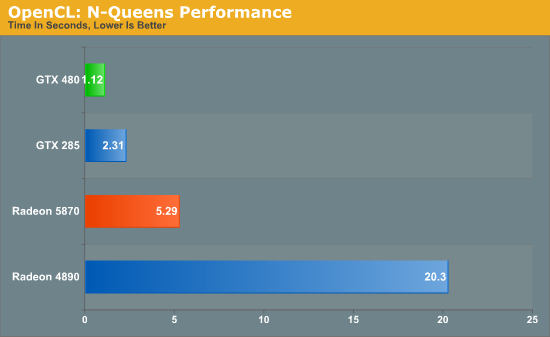
This benchmark offers a distinct advantage to NVIDIA GPUs, with the GTX cards not only beating their AMD counterparts, but the GTX 285 also beating the Radeon 5870. Due to the significant underlying differences of AMD and NVIDIA’s shaders, even with a common API like OpenCL the nature of the algorithm still plays a big part in the performance of the resulting code, so that may be what we’re seeing here. In any case, the GTX 480 is the fastest of the GPUs by far, beating out the GTX 285 by over half the time, and coming in nearly 5 times faster than the Radeon 5870.
Our second OpenCL benchmark is a post-processing benchmark from the GPU Caps Viewer utility. Here a torus is drawn using OpenGL, and then an OpenCL shader is used to apply post-processing to the image. Here we measure the framerate of the process.
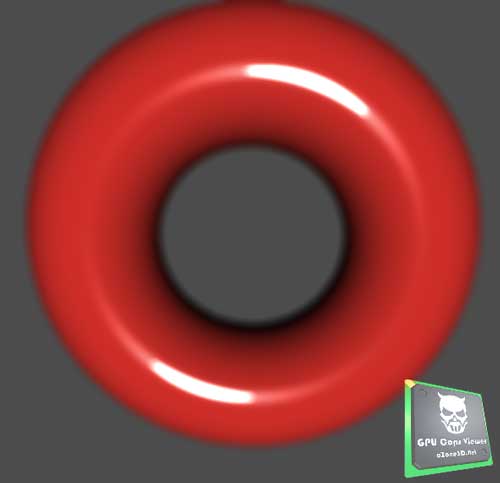
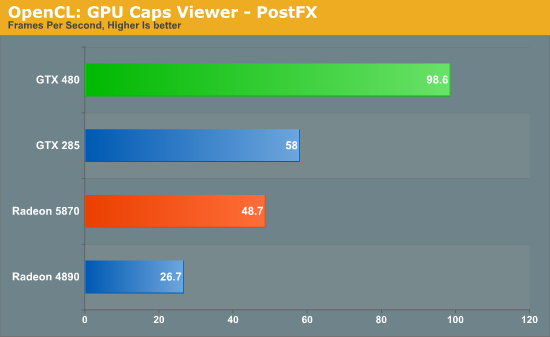
Once again the NVIDIA cards do exceptionally well here. The GTX 480 is the clear winner, while even the GTX 285 beats out both Radeon cards. This could once again be the nature of the algorithm, or it could be that the GeForce cards really are that much better at OpenCL processing. These results are going to be worth keeping in mind as real OpenCL applications eventually start arriving.
Moving on from cross-GPU benchmarks, we turn our attention to CUDA benchmarks. Better established than OpenCL, CUDA has several real GPGPU applications, with the limit being that we can’t bring the Radeons in to the fold here. So we can see how much faster the GTX 480 is over the GTX 285, but not how this compares to AMD’s cards.
We’ll start with Badaboom, Elemental Technologies’ GPU-accelerated video encoder for CUDA. Here we are encoding a 2 minute 1080i clip and measuring the framerate of the encoding process.
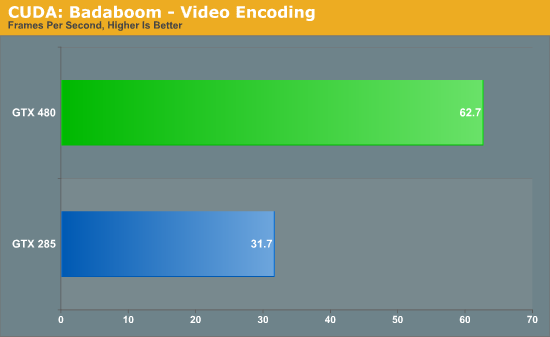
The performance difference with Badaboom is rather straightforward. We have twice the shaders running at similar clockspeeds, and as a result we get twice the performance. The GTX 480 encodes our test clip in a little over half the time it took the GTX 280.
Up next is a special benchmark version of Folding@Home that has added Fermi compatibility. Folding@Home is a Standford research project that simulates protein folding in order to better understand how misfolded proteins lead to diseases. It has been a poster child of GPGPU use, having been made available on GPUs as early as 2006 as a Close-To-Metal application for AMD’s X1K series of GPUs. Here we’re measuring the time it takes to fully process a sample work unit so that we can project how many nodes (units of work) a GPU could complete per day when running Folding@Home.

Folding@Home is the first benchmark we’ve seen that really showcases the compute potential for Fermi. Unlike everything else which has the GTX 480 running twice as fast as the GTX 285, the GTX 480 is a fewtimes faster than the GTX 285 when it comes to folding. Here a GTX 480 would get roughly 3.5x as much work done per day as a GTX 285. And while this is admittedly more of a business/science application than it is a home user application (even if it’s home users running it), it gives us a glance at what Fermi is capable when it comes to compuete.
Last, but not least for our look at compute, we have another tech demo from NVIDIA. This one is called Design Garage, and it’s a ray tracing tech demo that we first saw at CES. Ray tracing has come in to popularity as of late thanks in large part to Intel, who has been pushing the concept both as part of their CPU showcases and as part of their Larrabee project.

In turn, Design Garage is a GPU-powered ray tracing demo, which uses ray tracing to draw and illuminate a variety of cars. If you’ve never seen ray tracing before it looks quite good, but it’s also quite resource intensive. Even with a GTX 480, with the high quality rendering mode we only get a couple of frames per second.
On a competitive note, it’s interesting to see NVIDIA try to go after ray tracing since that has been Intel’s thing. Certainly they don’t want to let Intel run around unchecked in case ray tracing and Larrabee do take off, but at the same time it’s rasterization and not ray tracing that is Intel’s weak spot. At this point in time it wouldn’t necessarily be a good thing for NVIDIA if ray tracing suddenly took off.
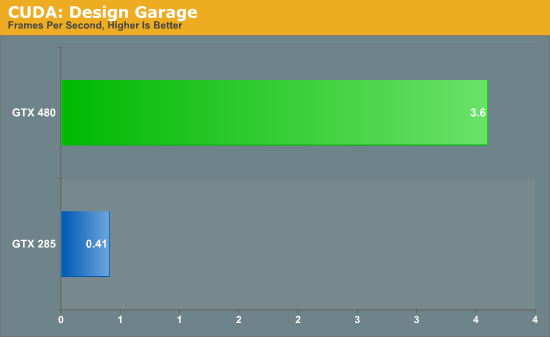
Much like the Folding@Home demo, this is one of the best compute demos for Fermi. Compared to our GTX 285, the GTX 480 is eight times faster at the task. A lot of this comes down to Fermi’s redesigned cache, as ray tracing as a high rate of cache hits which help to avoid hitting up the GPU’s main memory any more than necessary. Programs that benefit from Fermi’s optimizations to cache, concurrency, and fast task switching apparently stand to gain the most in the move from GT200 to Fermi.










196 Comments
View All Comments
ol1bit - Thursday, April 1, 2010 - link
I thought it was a fare review. They talked about the heat issues, etc.You can't compare a 2 GPU card to a single GPU card. If they ever make a 2 core GF100, I'm sure Anandtech will do a review.
IceDread - Tuesday, April 6, 2010 - link
You are wrong. You can and you should compare single gpu cards with multi gpu cards. It does not matter if a card has one or 30 gpu's on the card. It's the performance / price that matters.These nvidia cards are very expensive in performance / price compared to the ATI cards, simple as that. It's obvious that nvidia dropped the ball with their new flagship. You even need 2 cards to be able to use 3 screens.
This is bad for us customers, we are not getting any price pressure at all. These nvidia cards does not improve the market since they can not compete with the ATI card, only nvidia fans will purchase these cards or possibly some working with graphics.
I hope nvidia will do better with their next series or cards and I hope that won't take to long because ATI will most likely release a new series in half a year or so.
xxtypersxx - Sunday, March 28, 2010 - link
I will be interested in seeing the performance gains that will likely come from revised Nvidia drivers in a month or two. In some of the tests the gtx470 is trading blows with the gtx285 despite having nearly double the compute power...I think there is a lot of room for optimization.I am no fanboy and even owned a 4850 for a while, but Nvidia's drivers have always been a big decision factor for me. I don't get any of the random issues that were common on catalyst and aside from the occasional hiccup (196.67 G92 fan bug) I don't worry about upgrades breaking things. I admit I don't know if all the 5xxx series driver issues have been fixed yet but I do look forward to driver parity, until then I think raw performance is only part of the equation.
GourdFreeMan - Sunday, March 28, 2010 - link
Ryan, have you checked performance and/or clocks to see if any of the cards you are testing are throttling under FurMark? I recall you mentioning in your 58xx review that ATi cards can throttle under FurMark to prevent damage, and while most of the power numbers look normal, I notice a few of the cards are consuming less power under FurMark than Crysis, unlike the majority of the cards which consume considerably more power running FurMark than Crysis...MojaMonkey - Sunday, March 28, 2010 - link
I can turn off one light in my house and remove the power consumption difference between the GTX480 and the 5870.I thought this was an enthusiast site?
I lol irl when people talk about saving 100 watts and buying a 5870. So saving 100 watts but building a 700 watt system? Are you saving the planet or something?
I think nVidia is smart, if you fold or use cuda or need real time 3d performance from a quadro you will buy this card. That probably is a large enough market for a niche high end product like this.
PS: 5870 is the best gaming card for the money!
Paladin1211 - Sunday, March 28, 2010 - link
No, the 5850 is.p/s: I misclicked the Report instead of Reply button, so pls ignore it T_T
kallogan - Sunday, March 28, 2010 - link
Seriously i wonder who'd want gpus that power angry, noisy and hot...Nvidia is out both on mobile and desktop market...The only pro for Nvidia i can see is the 3D support.beginner99 - Sunday, March 28, 2010 - link
This is kind of bad for consumers. 0 pressure on ATI to do anything from lower price to anything else. they can just lay back and work on the next gen.Well, that at least made my decision easy. build now or wait for sandybridge. I will wait. hoepfully gpu marekt will be nicer then too (hard to be worse actually).
C5Rftw - Sunday, March 28, 2010 - link
I was waiting for the fermi cards to come out before my next high end build( looking for price drops), but I actually did not expect this card to be this fast. The GTX480 is ~15% faster than the 5870, but for $100 more, and it is just gonna be a Nvidia loyal card, and the 5870 will probably drop just a little if at all.. The 5850 and and 5830 should drop $25-50, hopefully more(2x5850 at ~250$ each would be FTW). Now, would I like to have a fermi?, well yeah for sure, but I would much rather have a 5870 and down the road add another. A GTX 480 uses the same, if not more power than (2) 5870's. Now this reminds me of the last gen of the P4's. or as we know em, the Preshots. Basically, Nvidia's idea of a huge chip approach, with yes impressive performance, was just the wrong approach. I mean, their next-gen, if based on this same "doubling" SPs, cuda cores, would draw 300w+ easily and almost require water cooling because the next TSMC process is going to be 32nm and that will not allow them to "cut the chip in half." ATI's theory started with the 4000 series has proven to be a much better/efficient design. I think they could make a 6870 using 40nm TSMC right now, but ofcourse it would be a hot chip. Now when they get the 32 TSMC FABs running, Nvidia has got to re-design their chips.. And with how hot the GTX 480 is, I dont see how they could make a GTX 495. Also, the 5890 is right around the corner and that should give the final punch to KO Nvidia in this GPU generation. On a side note, Thank " " that there is some healthy competion or AMD might pull what Nvidia did and rebrand the 8800 5 or 6 times.Belard - Sunday, March 28, 2010 - link
Keep in mind, the GeForce 480 (GTX means nothing, see any GTX210 or GT 285?) is already the most power hungry card on the market, just under 300watts under full load.... if the GF480 had all 512 Cuda Cores running and clocked higher... the card will easily surpass 300watts!This in turn means MORE heat, more power, more noise. There are videos on the 480/470s & ATI cards... the 480's fan is running very fast and loud to keep it under 100c, about 2~3 times hotter than a typical CPU.
We will see the ATI 6000 series on 40nm, but it may not be with TSMC.
If the upcoming 5890 is 15% faster and can sell for $400~450, that would put some hurt on the GF480.
Not sure how/why ATI would do re-branding. The 4670 is almost like a 3870, but is easily a more advanced and cheaper GPU. The bottom end GPUs have all changed. 2400 / 3450, 4350, 5450 - all different.
Nvidia has been doing re-branding for quite a long time. The GF2mx was re-branded as the GF2MX 400 (These were bottom end $150~190 cards in 2001) and then for some bone-head reason, during the GF6 era - they brought back the GF2MX but added DX8. Huh? Add a function to an OLD bottom end GPU?
The GF2-TI came out when GF3-TI series was launched... they wanted "TI" branding. The GF2-TI was a rebranded GF2-Pro with a slight clock upgrade.
Then came the first big-branding/feature fiasco with Nvidia. The GF8 was the first DX8 cards. Then the GF 4 series came out. The GF4ti were the high end models. But the MX series were nothing more than GF2 (DX7) with optional DVI... to take care of the low end and shove the letter names to the front.
GF4 mx420 = GF2mx, but a bit slower.
GF4 mx440 = GF2 Pro/TI
GF4 mx460 = ... faster DX7 card, but it was about $20~35 cheaper than the GF4-TI4200, a DX8 card. The Ti4200 was a #1 seller at about $200. Some of the 440se & 8x models may have 64 or 128bit RAM... ugh.
Then they had fun with the TI series when AGP 8x came out... NEW models! Either thou the cards couldn't max out the AGP 4x bus. Even the future ATI 9800Pro only ran 1~3% faster with AGP 8x.
GF4 Ti 4200 > GF4 Ti 4200 8x
GF4 Ti 4400 > GF4 Ti 4800 SE
GF4 Ti 4600 > GF4 Ti 4800
Yep, same GPUs... new names. Some people would upgrade to nothing or worse. Some even went from the 4600 to the 4800SE which was a downgrade!
GF5 5500 = 5200
Since the GF5... er "FX" series, Nvidia kept the DX# and feature set within the series. All GF5 cards are DX9.
But the 5200s were a joke. By the time they hit the market at $120, the Ti4200s were also $120 and the 4mx were reduced to $30~60. But the 5200 was HALF the performance of a 4200. People actually thought they were upgrading... returns happened.
Funny thing once. A person bought a "5200" at walmart and was confused by the POST display of "4200". Luckily he had posted to us on the interent. We laughed our butts off...! What happened? Batch & switch... someone bought a 5200, took it home - switched cards, took it back to Walmart for a refund. hey, its usually a brick or a dead card, etc. he got used card, but a much better product.
Like the ATI 5450 is too slow for gaming today for DX11, the GF5200 was horrible back in 2003 for DX9! The 5200 is still sold today, the only thing left.
Pretty much the entire GF5 series was utter garbage. 4 versions of the GF5600 ($150~200) were slower than the previous $100 Ti 4200. It was sick. This allowed ATI to gain respect and marketshare with their ATI 9600 & 9700 cards. The GF 5700 series (2 out of 5 types) were good Ti4200 replacements. The 5900 went up against the ATI 9800. I've owned both.
Since then, ATI pretty much had the upper hand in performance throughout the GF6 & GF7 era. AMD buys out ATI, then the GF8 and core2 wipes out ATI/AMD with faster products.
While ATI had the faster cards during DX9.0c (really MS? Couldn't make 6.1, 6.2?) era over the GF6/7... Nvidia *HAD* the lower end market. The GF6600 and 7600GT were $150~200 products... ATI products in that price range were either too slow or cost too much.
With GF 8800 & 8600s, ATI had lost high & mid-range markets. The HD 2000 series = too expensive, too hot and not fast enough... (sound familiar). The ATI 3000 series brought ATI back to competitive position where it counted. Meanwhile, Nvidia milked the G92~96 for the past 2+ years. They are code-name & model number crazy happy.
As long as ATI continues doing engineering and management this way, nVidia will continue to be in trouble for a long time unless they get their act together or count on the server market to stay in business.
End of short history lesson :0